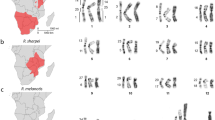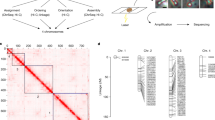Abstract
Synthetic F1 hybrids between individuals taken from selected populations of the northern (Glenn Innés, Bolivia Hill) and southern (Forbes Creek, Mount Aggie) chromosome races of the grasshopper Cryptobothrus chrysophorus confirm that these two ‘races’ are indeed distinguished by fixed differences in heterochromatin content. These differences affect five of the six medium sized members of the complement (M 4, 5, 6, 8 and 9). Added to this there is a marked change in the character of the remaining medium pair (M 7) which functions as the megameric in this species. — Meiosis in F1 males is characterised by the presence of univalency in from 22–32% of the meiocytes. This appears to be genotypic in causation and may involve from one to three chromosome pairs in any one cell. Laggards produced from such univalents lead to a failure of anaphase separation at either first or second division or at both of them. Consequently from 17–36% of the sperm produced are giant (diploid or tetraploid) in size. Added to this the medium members commonly form end to end associations involving the heterochromatic (northern race) and euchromatic (southern race) terminii. This is a modified form of the heterochromatic end associations which occur between homologous medium pairs in northern populations. The two small pairs (S10 and 11) show comparable behaviour in both races when they carry terminal heterochromatic supernumerary segments. Such associations persist despite the fact that they are non-chiasmate in character. Moreover, despite the asynapsis found in F1 males they produce F2s when allowed to intersib mate, although many of the embryos fail to develop, presumably as a result of genotypic imbalance, or else are aneuploid in constitution. In the F2s that do survive to maturity the chromosome differences which distinguish the northern and southern forms are recombined to give a wide variety of karyotypes in which the observed pairing is much improved and from which F3s were subsequently obtained.
Similar content being viewed by others
References
Craddock, E.M.: Intra-specific karyotypic differentiation in the Australian phasmatid Didymuria violescens (Leach) I. The chromosome races and their structural and evolutionary relationships, Chromosoma (Berl.) 53, 1–24 (1975)
Hewitt, G.M.: Variable transmission rates of a B-chromosome in Myrmeleotettix maculatus (Thunb.) (Acrididaei:Orthoptera). Chromosoma (Berl.) 40, 83–106 (1973)
John, B.: The cytogenetic systems of grasshoppers and locusts II. The origin and evolution of supernumerary segments. Chromosoma (Berl.) 44, 123–146 (1973)
John, B., Weismann, D.B.: Cytogenetic components of reproductive isolation in Trimerotropis thalassica and Trimerotropis occidentalis. Chromosoma (Berl.) 60, 187–203 (1977)
John, B., King, M.: Heterochromatin variation in Cryptobothrus chrysophorus I. Chromosome differentiation in natural populations. Chromosoma (Berl.), 64, 219–239 (1977a)
John, B., King, M.: Heterochromatin variation in Cryptobothrus chrysophourus II. Patterns of C-banding. Chromosoma (Berl.), 65, 59–79 (1977b)
John, B., Miklos, G.L.G.: Functional aspects of heterochromatin and satellite DNA. Int. Rev. Cytol. 58, 1–114 (1979)
King, M., John, B.: Regularities and restrictions governing C-band variation in acridoid grasshoppers. Chromosoma (Berl.) 76, 123–150 (1980)
Lucov, Z., Nur, U.: Accumulation of B-chromosomes by preferential segregation in females of the grasshopper Melanoplus femur-rubrum. Chromosoma (Berl.) 42, 289–306 (1973)
Miklos, G.L.G., John, B.: Heterochromatin and satellite DNA in man: properties and prospects. Amer. J. Hum. Genet. 31, 264–280 (1979)
Moran, C.: Population studies of Caledia captiva (Orthoptera: Acridinae) in S.E. Queensland. PhD thesis, Australian National University 1978
Peters, G.B.: Germ line polysomy in Atractomorpha similis. PhD thesis, Australian National University 1977
Rees, H., Shaw, D.D., Wilkinson, P.: Nuclear DNA variation among acridoid grasshoppers. Proc. roy Soc. Lond. B 202, 517–525 (1978)
Rothfels, K., Procunier, W.A.: B-chromosomes of Neopodismopsis abdominalis (Acrididae). Chromosoma (Berl.) 52, 137–148 (1975)
Shaw, D.D., Wilkinson, P.: “Homologies” between non-homologous chromosomes in the grasshopper Caledia captiva. Chromosoma (Berl.) 68, 241–259 (1978)
Webb, C.G.: Chromosome organisation in the Australian plague locust Chortoicetes terminifera I. Banding relationship of the normal and supernumerary chromosomes. Chromosoma (Berl.) 55, 229–246 (1976)
White, M.J.D., Blackith, R.E., Blackith, R.M., Cheney, J.: Cytogenetics of the viatica group of morabine grasshoppers I. The coastal species. Aust. J. Zool. 15, 263–302 (1967)
Author information
Authors and Affiliations
Rights and permissions
About this article
Cite this article
John, B., King, M. Heterochromatin variation in Cryptobothrus chrysophorus . Chromosoma 78, 165–186 (1980). https://doi.org/10.1007/BF00328390
Received:
Issue Date:
DOI: https://doi.org/10.1007/BF00328390




